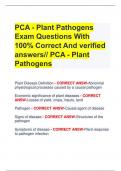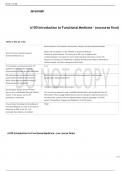Physiological processess - Study guides, Class notes & Summaries
Looking for the best study guides, study notes and summaries about Physiological processess? On this page you'll find 19 study documents about Physiological processess.
All 19 results
Sort by

-
PCA - Plant Pathogens Exam Questions With 100% Correct And verified answers// PCA - Plant Pathogens Plant Disease Definition - CORRECT ANSW-Abnormal physiological processes caused by a causal pathogen Economic significance of plant diseases -
- Exam (elaborations) • 53 pages • 2024
-
- $11.99
- + learn more
PCA - Plant Pathogens Exam Questions With 100% Correct And verified answers// PCA - Plant Pathogens Plant Disease Definition - CORRECT ANSW-Abnormal physiological processes caused by a causal pathogen Economic significance of plant diseases - CORRECT ANSW-Losses of yield, crops, inputs, land Pathogen - CORRECT ANSW-Causal agent of disease Signs of disease - CORRECT ANSW-Structures of the pathogen Symptoms of disease - CORRECT ANSW-Plant response to pathogen infecti...

-
NR-283 Week 6 Pathophysiological Processes (RUA): Sleep Apnea
- Case • 9 pages • 2022
-
Available in package deal
-
- $10.99
- + learn more
Obstructive Sleep Apnea Chamberlain College of Nursing Pathophysiology NR:283 Introduction Sleep apnea causes a person’s breathing to rapidly cease and restart during sleep. There are se veral types of sleep disorders, but this RUA will only discuss obstructive sleep apnea. This type of sleep disturbance can occur when the oropharyngeal structures slacken and block the airway during rest, one of the signs of obstructive sleep apnea is snoring during rest. Obstructive sleep apnea is marked by r...

-
NR 283 Week 6 Pathophysiological Processes (RUA): The Epidemiology of Acute Myocardial Infarction (GRADED A)
- Case • 7 pages • 2022
-
Available in package deal
-
- $10.99
- + learn more
The Epidemiology of Acute Myocardial Infarction Chamberlain University College of Nursing NR283: Pathophysiology The Epidemiology of Acute Myocardial Infarction According to Mechanic and Grossman (2020), there are over three million people in the world each year that are dying from a very serious disease of Acute Myocardial Infarction (Acute MI) also commonly known as a Heart Attack, in which more than over one million of that number of deaths are in the United States. An Acute Myocardial Infarc...

-
NR-283 Week 6 Pathophysiological Processes (RUA): Melanoma | GRADED
- Case • 5 pages • 2022
-
Available in package deal
-
- $10.99
- + learn more
Melanoma Chamberlain College of Nursing NR283: Pathophysiology Melanoma Introduction of Disease Melanoma is a malignant form of skin cancer. While it is not the most common form of skin c ancer, it is the deadliest. Melanocytes are cells found on the border of the epidermis and dermis. When they are exposed to UV rays they produce more melanin which gives the skin a darker pigmentation. “The incidence of malignant melanoma has been rising steadily for at least the past 30 years, and it has now...

-
NR 283 Week 6 Pathophysiological Processes (RUA): Sickle Cell Anemia in African Countries (GRADED)
- Case • 6 pages • 2022
-
Available in package deal
-
- $10.99
- + learn more
Sickle Cell Anemia Chamberlain College of Nursing NR 283: Pathophysiology Sickle Cell Anemia Approximately 60 % of individuals with Sickle Cell Anemia live in Sub Saharan Africa. Each year about 300,000 infants are born with major hemoglobin disorders- including more than 200,000 cases of Sickle Cell Anemia in Africa. (Munube et al., 2016). Sickle Cell Anemia is a common genetic condition due to a hemoglobin (Hb) disorder inheritance of mutant hemoglobin genes from both parents. Normally, your r...

-
NR 283 Week 6 Pathophysiological Processes (RUA): Human Papillomavirus (HPV) Infection (GRADED)
- Case • 6 pages • 2022
-
Available in package deal
-
- $10.99
- + learn more
Chamberlain University College of Nursing NR283: Pathophysiology Epidemiology In the United States, there are about 80 million individuals that are diagnosed with the human papillo mavirus (HPV), and every day there are 14 million new cases of HPV that are contracted by people between the ages 15 and 59 years (Schub & Parks-Chapman J, 2017). The Centers for Disease Control and Prevention (CDC) informs that human papillomavirus is a virus with a double stranded DNA that affects the epithelial tis...

-
NR-283 Week 6 Pathophysiological Processes (RUA): Chronic Obstructive Pulmonary Disease (COPD) | GRADED
- Case • 6 pages • 2022
-
Available in package deal
-
- $10.99
- + learn more
Emphysema Chamberlain College of Nursing NR283 Emphysema Emphysema is a form of Chronic Obstructive Pulmonary Disorder (COPD) and is a chronic respiratory disease where lung function declines over time, leading to respiratory symptoms such as dyspnea, cough, and production of sputum (Rycroft et al., 2012). Patients with Emphysema have destroyed alveolar sacs, along with thickened and inflamed airways with increased mucus production causing the airway to clog. People are more susceptible to being...

-
Jeremiah 6100 Introduction to Functional Medicine - (no course final) Terms in this set (110) One of the most important goals of Functional Medicine is to Restore balance in the patient's environment, lifestyle, and physiological processes
- Exam (elaborations) • 10 pages • 2024
-
- $7.89
- + learn more
Jeremiah 6100 Introduction to Functional Medicine - (no course final) Terms in this set (110) One of the most important goals of Functional Medicine is to Restore balance in the patient's environment, lifestyle, and physiological processes Please refer to Chapter 2 of the Textbook of Functional Medicine. FM aims to restore balance. The main goal of FM is not to diagnose the condition/disease or to assess the correct pharmaceutical intervention. In fact, FM focuses on ...

-
NR 283 Week 6 RUA: Pathophysiological Processes Guidelines: Melanoma (GRADED)
- Case • 5 pages • 2022
-
- $10.99
- + learn more
Melanoma Chamberlain College of Nursing NR283: Pathophysiology Spring Session A Melanoma Introduction of Disease Melanoma is a malignant form of skin cancer. While it is not the most com mon form of skin cancer, it is the deadliest. Melanocytes are cells found on the border of the epidermis and dermis. When they are exposed to UV rays they produce more melanin which gives the skin a darker pigmentation. “The incidence of malignant melanoma has been rising steadily for at least the past 30 year...

-
(CASE STUDY) NR-283 Week 6 RUA: Pathophysiological Processes Guidelines: Sickle Cell Anemia in African Countries
- Case • 6 pages • 2022
-
- $10.99
- + learn more
Sickle Cell Anemia Chamberlain College of Nursing NR 283: Pathophysiology Sickle Cell Anemia Approximately 60 % of individuals w ith Sickle Cell Anemia live in Sub Saharan Africa. Each year about 300,000 infants are born with major hemoglobin disorders- including more than 200,000 cases of Sickle Cell Anemia in Africa. (Munube et al., 2016). Sickle Cell Anemia is a common genetic condition due to a hemoglobin (Hb) disorder inheritance of mutant hemoglobin genes from both parents. Normally, your ...

Did you know that on average a seller on Stuvia earns $82 per month selling study resources? Hmm, hint, hint. Discover all about earning on Stuvia


